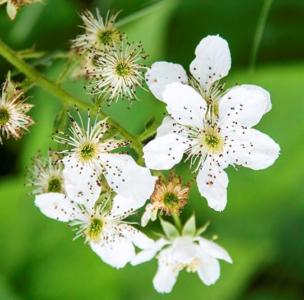Roseleaf Bramble
(Rubus rosifolius)

Description
Rubus rosifolius, commonly known as the roseleaf bramble or the rose-leaf raspberry, is a species of flowering plant that belongs to the Rosaceae family. This fascinating plant is native to the forests and coastal areas of Australia and New Zealand, where it thrives in a diverse range of habitats. With its beautiful rose-like foliage, delicate flowers, and edible fruits, Rubus rosifolius has captured the hearts of plant enthusiasts and gardeners around the world. In this article, we will explore the various aspects of this remarkable species, from its taxonomy and morphology to its ecological role and cultivation. Taxonomy and Classification Rubus rosifolius falls within the Kingdom Plantae, Phylum Magnoliophyta, Class Magnoliopsida, Order Rosales, Family Rosaceae, and Genus Rubus. The genus Rubus encompasses hundreds of species, including raspberries, blackberries, and dewberries. Rubus rosifolius was first described by the botanist Robert Brown in 1810. Its scientific name "rosifolius" is derived from the Latin words "rosa" meaning "rose" and "folius" meaning "leaf," referring to the plant's leaf structure reminiscent of rose leaves. Morphology and Characteristics The roseleaf bramble is a sprawling, evergreen shrub with arching canes that can grow up to 2 to 3 meters in length. Its stems are armed with sharp thorns, making it a formidable barrier against intruders. The leaves of Rubus rosifolius are compound and palmate, consisting of three to five leaflets. Each leaflet is elliptical in shape with serrated margins, resembling the leaves of a rose plant. The upper surface of the leaflets is dark green, while the lower surface is pale green or whitish. During the blooming season, Rubus rosifolius produces clusters of small, fragrant flowers. The blossoms are typically white or pale pink, with five petals and a prominent cluster of yellow stamens at the center. These flowers attract various pollinators, including bees, butterflies, and birds, contributing to the plant's reproductive success. Following pollination, the flowers give rise to small, round fruits known as drupes. The drupes of Rubus rosifolius are initially green and turn into vibrant red or orange-red when ripe. Each drupe contains numerous tiny, edible seeds, which are dispersed by birds and other animals that consume the fruit. Ecological Role and Habitat Rubus rosifolius plays a crucial ecological role in its native habitats. The dense thickets formed by its sprawling canes provide shelter and protection for various small animals and birds. The sharp thorns act as a deterrent against herbivores, ensuring the plant's survival. Additionally, the flowers of Rubus rosifolius serve as a valuable nectar source for pollinators, promoting the biodiversity of the surrounding ecosystem. This species is commonly found in the understory of forests, as well as in coastal areas, dunes, and disturbed habitats. It exhibits a remarkable adaptability to different soil types, including sandy soils and clay loams. Rubus rosifolius is well-suited to temperate and subtropical climates, thriving in regions with mild winters and moderate rainfall. Cultivation and Uses Rubus rosifolius has gained popularity among gardeners for its ornamental value and edible fruits. It can be grown in both containers and garden beds, provided it receives adequate sunlight and well-drained soil. The plant's sprawling habit can be controlled through regular pruning and training, making it suitable for smaller gardens as well. When cultivating Rubus rosifolius, it is recommended to propagate the plant through stem cuttings or by layering. Stem cuttings should be taken from healthy, mature plants during the dormant season and planted in a well-prepared soil mix. Layering involves bending a flexible cane to the ground, covering a portion of it with soil, and allowing it to root before detaching it from the parent plant. In terms of maintenance, it is important to provide regular watering to ensure the soil remains evenly moist, especially during dry periods. Applying a layer of organic mulch around the base of the plant helps retain moisture and suppresses weed growth. Pruning should be done during the late winter or early spring to remove dead or damaged canes and to maintain a desirable shape and size. Additionally, it is essential to wear protective clothing when handling the plant due to its thorny nature. One of the most appealing aspects of Rubus rosifolius is its fruit, which is not only visually appealing but also edible. The ripe drupes are sweet and juicy, with a unique flavor that blends the tartness of raspberries with the sweetness of blackberries. They can be eaten fresh, used in jams, jellies, and desserts, or even transformed into refreshing beverages. The fruits are also rich in vitamin C and contain beneficial antioxidants. Beyond its ornamental and culinary uses, Rubus rosifolius has been employed in traditional medicine. The leaves of the plant are known for their astringent and anti-inflammatory properties. They have been used in herbal remedies to treat ailments such as diarrhea, dysentery, and sore throats. However, it is important to consult with a qualified herbalist or healthcare professional before using any plant for medicinal purposes. Conservation Status and Concerns While Rubus rosifolius is not currently listed as a threatened species, it is important to consider its potential impact on ecosystems where it has been introduced outside of its native range. In some regions, such as Hawaii and parts of New Zealand, the plant has become invasive, outcompeting native vegetation and negatively affecting biodiversity. Therefore, it is crucial to exercise caution when cultivating or introducing Rubus rosifolius in areas where it is not native, and to prevent its spread into natural habitats. Conclusion Rubus rosifolius, with its captivating rose-like foliage, delicate flowers, and delicious fruits, is a remarkable plant that adds beauty and utility to gardens and natural landscapes alike. Its adaptability, ornamental value, and culinary uses make it a favored choice among gardeners and plant enthusiasts. However, it is important to be mindful of its potential invasiveness in non-native habitats and to appreciate and cultivate it responsibly. With proper care and attention, Rubus rosifolius continues to charm and delight plant lovers around the world.
Taxonomic tree:







